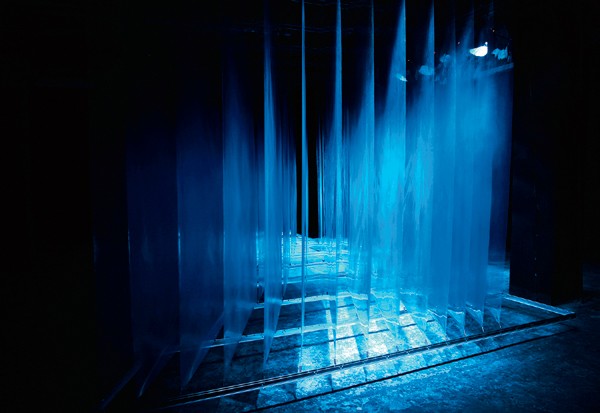Blue Who
David Spriggs
In his 1976 philosophical inquiry On Being Blue (DR Godine, 1975), William Gass inventories the ubiquity of his chosen colour: “Blue occurs everywhere, in ice and water, in the flame as purely as in the flower, overhead and inside caves, covering fruit and oozing out of clay.” Were he to add a supplementary chapter on where blue is most richly found today, he would have to continue his list with “and sublimely in between, around and above 54 sheets of spray-painted Mylar installed in a small, below-ground Canadian gallery.” Professor Gass would turn green with envy in the presence of Blue, the most recent installation by David Spriggs at Winnipeg’s Raw: Gallery of Architecture & Design through December 21, 2013.

Spriggs, who lives and works in Montreal, has a thing for colour and the various systems through which it is organized. In 2012 he designed a single installation for Art Mûr in Montreal called 4 Colour Separation (using the subtractive printing colours— cyan, magenta, yellow and black), and then three large-scale installations collectively called RGB (for the additive colour model—red, green and blue). Stratachrome, which used chroma-key green was installed at La Galerie de l’UQAM in Montreal in 2010, while Red was shown in 2012 in a three-storey-tall, graffiti-covered, abandoned power station in Prague. Its palette and scale had a special resonance in a country formerly controlled by Russia. Spriggs makes colour work in a way that is indescribably visceral (an in-body experience) and sublime (an out-of body inclination).

David Spriggs, Blue, 2012/13, blue acrylic on layered transparent film, mirrored foil, lighting, springs, T-bars, 262 x 650 x 326 cm. Installation view RAW: Gallery of Architecture & Design, Winnipeg. Photographs: David Spriggs.
Each of his pieces presents its own technical and aesthetic problems and each asks for a particular solution. Stratachrome was composed of 400 sheets of Mylar; Blue only 54. What they have in common is a component show-and-tell. Spriggs insists that his installations reveal how they work; he has no interest in either spectacle or mystery. So as you move around Raw Gallery, you see the T-bars and springs and lights that comprise the piece. “I like to show the side parts on all my works because they deal with the breakdown of form and volume. One of the overarching metaphorical themes I have worked with is power. So I like that moment where, as the viewer navigates the piece, it falls apart and then pulls itself together again.”

The experience of colour in Blue is utterly physical. You feel as if you have been seized by colour. What makes that reaction so extraordinary is that this embodied sensation is created out of almost nothing. As a viewer, you can move three feet to either side and see how little almost nothing actually is. Then you move back to look Blue in the face, and it makes the same powerful claim on your perceptual being that it had before you entered its simple technical workshop. In this hybrid space seamlessly existing between painting and sculpture and between two and three dimensions, the experience of seeing becomes tactile. “I’m not trying to pretend something,” Spriggs says, “it’s not trying to be a cloud, it’s this work called Blue in which I’m trying to present the objectification of this colour through space.”
Spriggs’s installations are ambitious in scale and aspiration. “What I want my art to have,” he says, “is this absolutely intense power to completely captivate and move the viewer.” He’s speaking to a captive audience.

